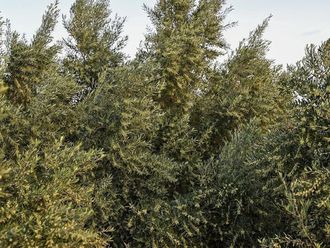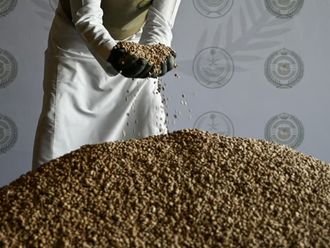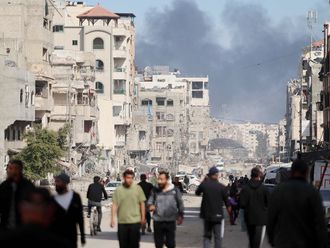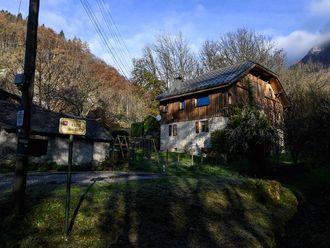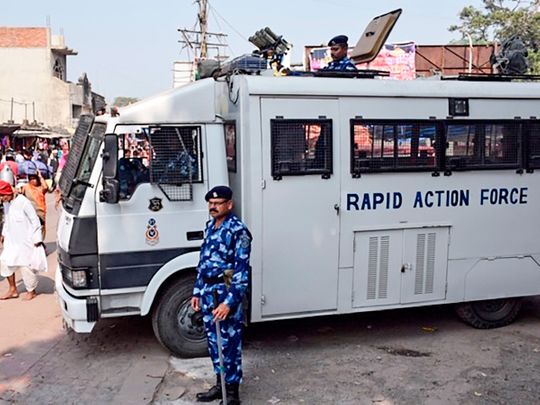
Dubai: Indian Supreme Court will deliver verdict in Ayodhya case on Saturday.
Earlier, Indian police said they have arrested more than 500 people ahead of a Supreme Court ruling on the hotly disputed religious site in the holy city of Ayodhya, media reports said, with authorities fearing the verdict could trigger unrest.
Thousands of paramilitaries have already been sent to the northern city in antici[ation of the decision on the future of the site claimed by both Hindus and Muslims.
Hindu hardliners want a temple built on the site, currently barricaded off decades after a 16th-century mosque there was demolished during 1992 riots that left 2,000 people dead.
Case history
The Supreme Court heard a batch of petitions challenging September 30, 2010, Allahabad High Court judgment trifurcating the 2.77 acres of the disputed land at Ayodhya into three equal parts among Ram Lalla, Sunni Waqf Board, and Nirmohi Akhara.
These three parties — Ram Lalla, Sunni Waqf Board and Nirmohi Akhara — however, knocked the door of the apex court challenging the Allahabad High Court verdict and sought the modification of the High Court judgment.
A five-judge bench of the Supreme Court has concluded the hearing in the Ayodhya land dispute case and reserved its verdict.
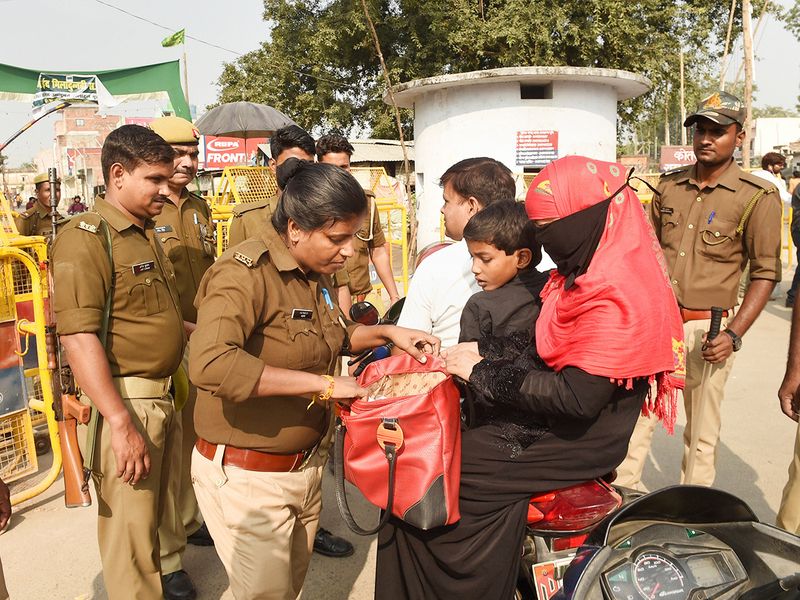
2019: Supreme Court sets up a five-judge Constitution Bench to hear the land dispute. The bench hears both sides. Supreme Court also tries to resolve the issue through 3rd party mediation but all attempts to do so fail.
2018: Supreme Court says the 'Ayodhya land dispute' case will be listed before an 'appropriate bench' in January 2019.
March 21, 2017: SC asked both the parties in the Ram Janmbhoomi-Babri Masjid dispute to resolve their differences amicably outside court and even offered to mediate.
February 26, 2016: SC permitted BJP leader Subramanian Swamy to intervene in the pending matters relating to the Ayodhya dispute with his plea seeking construction of Ram temple at the site of the demolished disputed structure.
September 28, 2010: The apex court rejected petition for deferment and gave nod to Allahabad HC to deliver the judgement. The HC ruled for a three-way division of the disputed area, between the Sunni Waqf Board, the Hindu Nirmohi Akhara and the party representing ‘Ram Lalla’ (deity Ram).
September 23, 2010: The plea for an out-of-court settlement reached Supreme Court (SC) and the apex body said it would hear it again on September 28.
September 14, 2010: A writ was filed to defer the judgement but was subsequently rejected by HC.
July 26, 2010: The HC Bench reserved its judgement and advised all parties to solve the issue amicably.
August 31, 2003: All India Muslim Personal Law Board said it would challenge the ASI report.
August 22, 2003: ASI submitted its report to the HC, saying it had found features of a tenth century temple beneath the site of the mosque.
March 5, 2003: The Allahabad High Court (HC) ordered the Archeological Survey of India (ASI) to excavate the disputed site in order to determine whether a temple existed where the mosque stood.
December 6, 1992: The Babri mosque was brought down by leaders and workers of VHP and Hindu fundamentalist outfit Rashtriya Swayamsewak Sangh (RSS) and a makeshift temple was placed in its place. The Congress government at the Centre moved court for a status quo.
September 25, 1990: Advani launched a procession to garner countrywide support for the construction of Ram temple.
1989: The then Prime Minister Rajiv Gandhi allowed ground-breaking ceremony at an undisputed site close to the Babri mosque structure.
February 1, 1986: Faizabad district judge ordered the gates of the structure be opened for Hindus to offer prayers. Babri Masjid Action Committee was formed soon after this.
1984: Hindu hardline body Vishwa Hindu Parishad (VHP) constituted a team to campaign for the construction of Ram temple at the disputed site. VHP chose Bharatiya Janata Party (BJP) leader LK Advani as the team head.
1961: Sunni Central Board of Waqfs filed a case claiming the Babri mosque, and argued that since the surrounding area was a graveyard, it should not be allocated for deity Ram.
1950: Chief of Ram Janmabhoomi Nyas (deity Ram Birthplace Movement) Mahant Paramhans Ramchandra Das filed suits in Faizabad in Uttar Pradesh (UP) seeking permission to pray before the idols installed inside the premises. The plea was allowed though the inner courtyard gates remained locked.
1949: In December 1949, idols of deity Ram were allegedly put inside the mosque by Hindus. It led to widespread protests and religious leaders of both Hindu and Muslim communities filed cases against each other. The government declared the site as disputed and locked the gates of the mosque.
1528: The Babri mosque was constructed in Ayodhya by the orders of Mughal emperor Babar. Hindus believe it was built on the foundations of a temple which marked the birthplace of Hindu deity Ram.
Modi calls for peace, unity
Indian PM Modi said the top court's verdict should not be considered as victory or defeat of any one section.
“Whatever be the decision of the Supreme Court on Ayodhya, it will not be a victory or defeat for anyone,” he tweeted. “My appeal to the countrymen is that it should be the priority of all of us that this decision should further strengthen the great tradition of peace, unity and goodwill of India,” he added.
Special prayers offered at Ahmedabad mosque
Special prayers were offered on Friday at a mosque in Ahmedabad's Usmapura area in anticipation of the Supreme Court verdict in the Babri Masjid Ram Janmabhoomi dispute case.
People offered prayers to maintain peace and harmony in the country.
Multi-layered security arrangements in place in Ayodhya
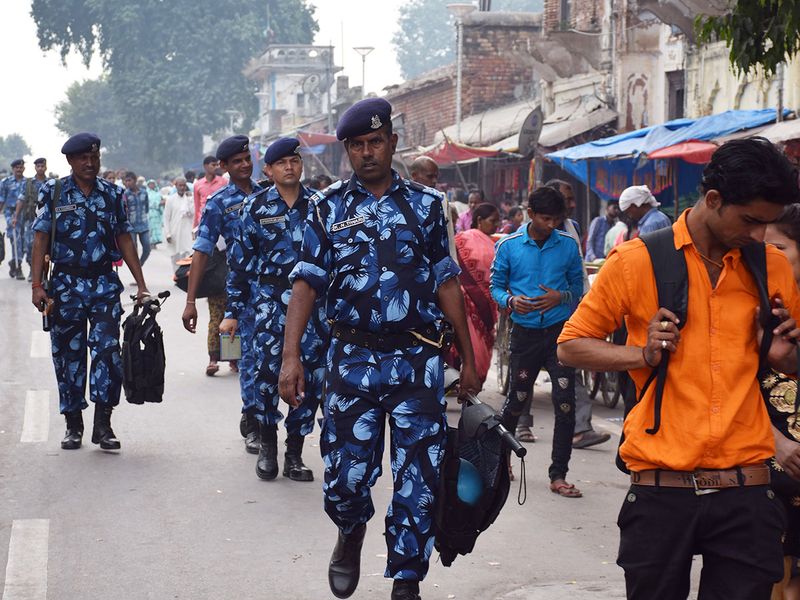
Multi-layered security arrangements have been put in place in the temple town of Ayodhya with drones being used to monitor the situation ahead of the apex court judgment in the Ramjanmabhoomi-Babri Masjid land dispute case.
Be it the area near the Ramjanmabhoomi police station, "karyashala" of Ram Janmabhoomi Nyas or other parts of the town, policemen could be seen checking two-wheelers.
Elaborating on the security arrangements, Additional Director General of Police (Law and Order) PV Ramasastry told PTI, "Adequate forces have been provided to Ayodhya and all sensitive districts of the state in good measure. The force has been sufficiently strengthened in terms of CAPF and PAC companies."
He said not only their number had been increased but the efficiency of the deployed forces was also being improved for the past two months by giving them better equipment and training.
Apart from this, senior officers were also involved in planning, he said.
When asked whether drone cameras will be used for monitoring purposes, Ramasastry said, "Drone cameras are being used in the preparatory phase so that the deployment of the forces can be planned correctly."
Drones to monitor vulnerable spots
He said drone cameras would also be used to closely monitor vulnerable spots and rooftops to prevent the accumulation of stones.
"For the past a couple of months, efforts have been made to increase effectiveness and efficiency of the security personnel," he said.
When asked on the possibility of deploying the NSG, the ADG said, "Not any. The NSG is available at their bases for any eventuality. We have deployed ATS units, bomb diffusion squads, anti-sabotage and quick response teams."
He informed that for more than a month, police had been trying to build confidence among people.
"Stress has been laid on confidence-building measures," he said, adding that police had undertaken patrolling and different sections of society, be it the dharma gurus, traders or academics had been contacted.
"The basic aim of the outreach is to instil a feeling of security," he said.
Speaking on security arrangements, ADG (Prosecution) Ashutosh Pandey said, "Sixty companies of the PAC and paramilitary forces have been deployed. As many as 10 drone cameras and CCTVs at 30 crossings have been installed."
Pandey said barricading had been strengthened at the place of the makeshift temple.
Elaborate security plans
The entire town had been divided into 31 sectors and 35 sub-sectors, he said, adding that in case there was a surge of visitors, a "holding area" had been carved on the outskirts of the town so that people could be sent in batches for the darshan of Lord Ram.
Pandey said there was no ban on devotees coming to Ayodhya.
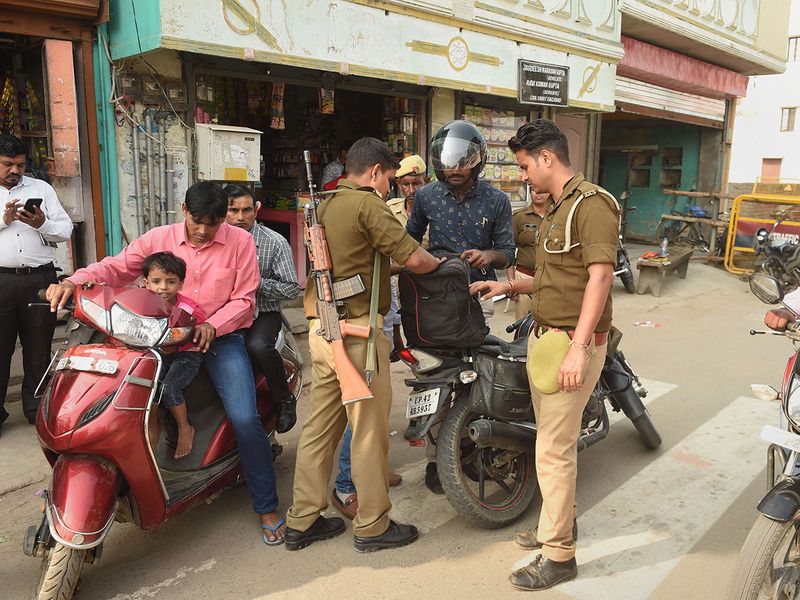
Uttar Pradesh Chief Minister Yogi Adityanath had earlier said two helicopters would be on standby in Lucknow and Ayodhya as part of the security arrangements.
Adityanath conveyed this during a late night videoconference with the state's top civil and police officials.
Helicopters would be used in case of an emergency, an official said.
An official release later said the chief minister reviewed the law and order situation in each district and gave necessary directions to ensure normalcy.
It was also decided that a state-level control room will be set up in Lucknow.
Every district would have a control room, the release said.
Delhi Police to ensure safety of religious places
Ahead of the judgment by the Supreme Court regarding Ayodhya matter, Delhi Police said that all necessary arrangements will be made to ensure safety and security of religious places.
"Delhi Police is planning elaborate police arrangements and all precautionary measures will be taken. Necessary arrangements will be made to ensure the safety and security of religious places. Field formations will remain in contact with stakeholders and meetings will be conducted with 'aman committees' comprising the respectables from different communities," Delhi Police said in a statement.
District police and Station House Officers have been directed to raise police visibility and patrolling in communally sensitive areas.
Delhi Police will also initiate strict legal action against mischief-mongers or those found indulging in any activity which may adversely affect the peace and tranquillity of the society.
"Social media platforms will also be monitored. The platform shall be used with discretion, and users should restrain from spreading any unverified post," the Delhi Police advises.
The sufficient police forces are being mobilised and Delhi Police will also requisition extra Central Armed Police Forces companies from Ministry of Home Affairs (MHA).
All should respect SC's Ayodhya verdict: Prince Yakub
Prince Yakub Habeebuddin Tucy, who claims to be a descendant of last Mughal emperor Bahadur Shah Zafar, on Friday appealed all to respect the Supreme Court's verdict on Ram Mandir-Babri Masjid land dispute and maintain peace and harmony.
Speaking to ANI, Prince Yakub said: "I would like to appeal everyone to respect the verdict of the Supreme Court. We should maintain peace and harmony in the wake of this verdict and celebrate the verdict as a matter of national importance like Independence Day and Republic Day."
"People from all communities should accept the judgment of the Supreme Court because the case is not between a temple and a mosque but it is a title dispute," he added.
Habeebuddin Tucy further stated that he hopes that the judgment will be in favor of the Ram Mandir.
"I hope that the judgment will be given for the Ram Mandir. If the Ram Mandir is built, then I will offer the first golden brick for the construction of the temple," he said.
"No mosque can be built or namaz can be offered on a disputed land," he added.



